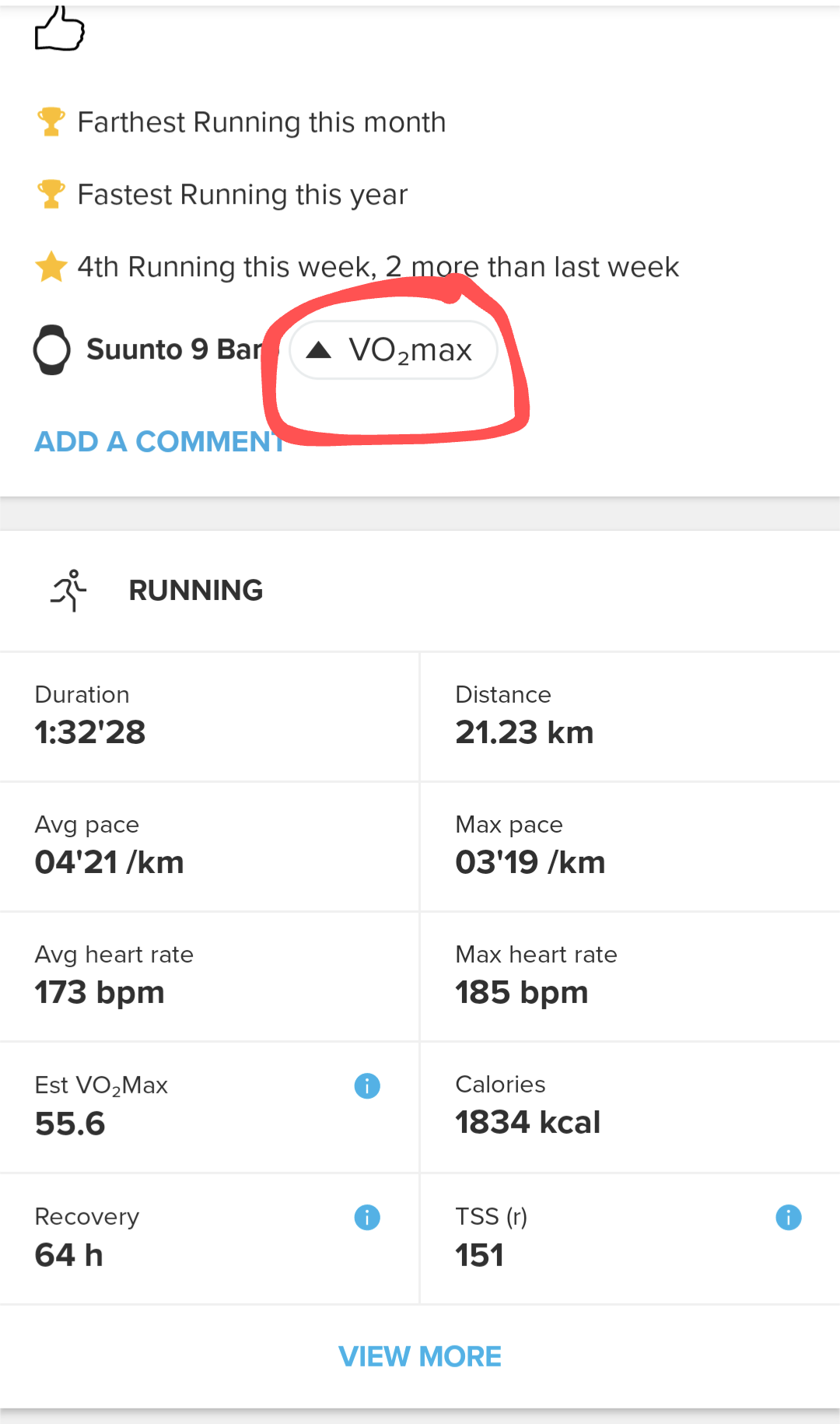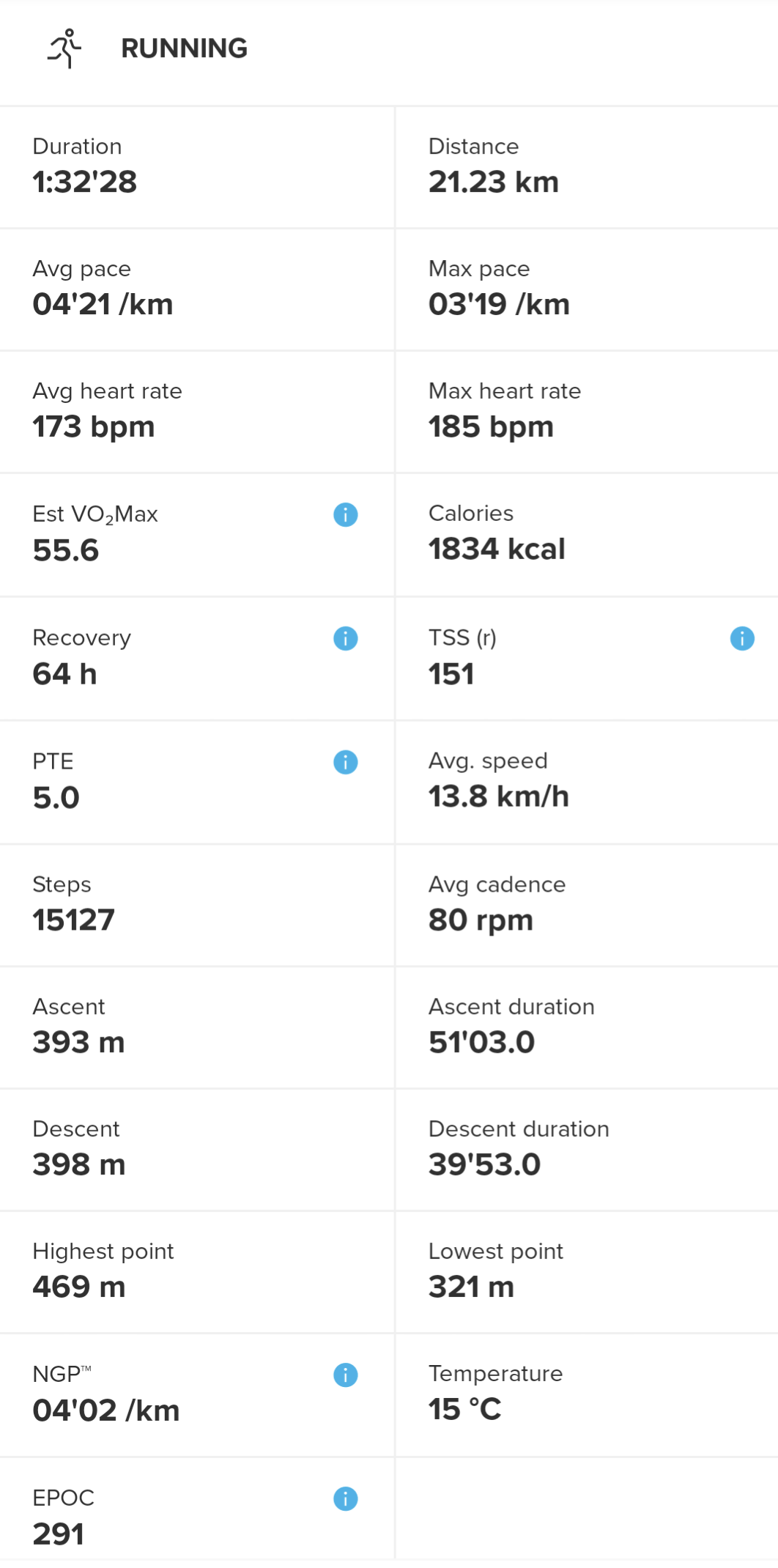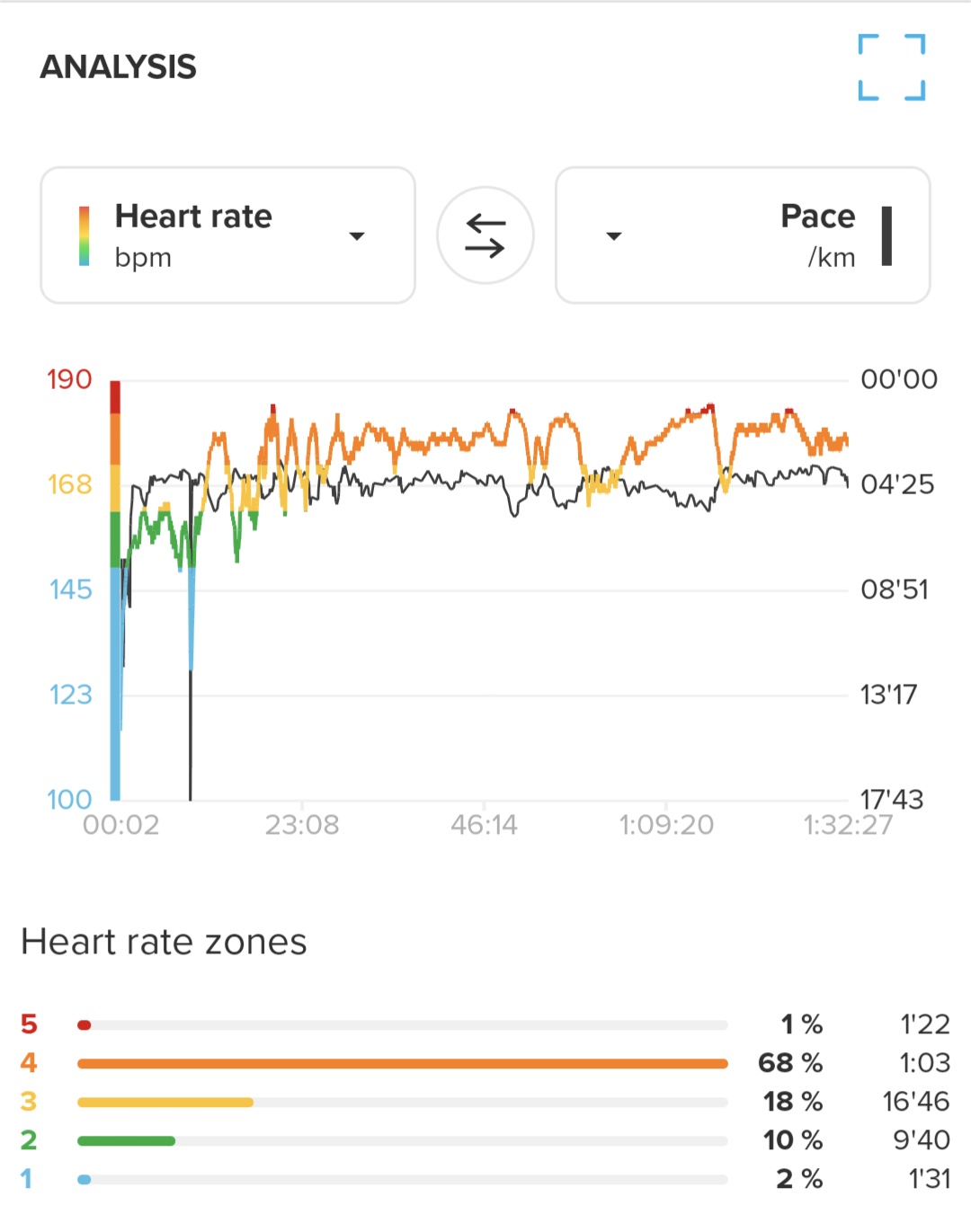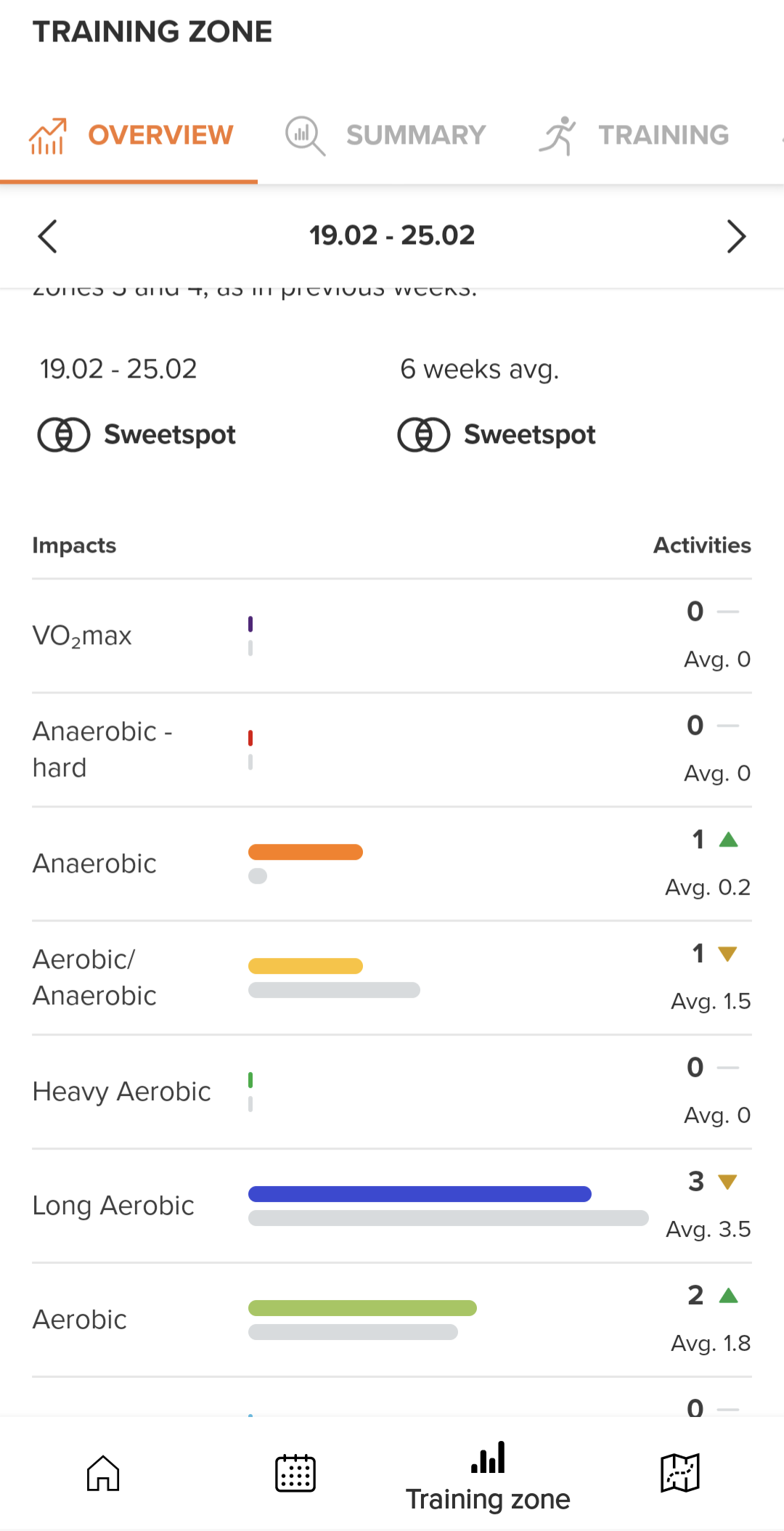How does Suunto App decide, what kind of training (aerobic, anaerobic, etc.) is it?
-
@Sebastian-Wagner-0 That seems pretty straightforward, I’m gonna do that test. The workout I did today was pretty similar so with some uncertainty I can say my zones are set pretty well. Definitely not exactly but “kinda”.
[EDIT] I’ve checked my data from the last year - during race (~75 minutes) I had mean HR 181. So it seems the estimate 183, which I am using now is pretty close.
@Brad_Olwin I’m sorry, but I’m a bit confused. I have an IT background so I am wondering how could be tags incorrect (technically) when the zones are incorrect? The input from user (me) is the zones - I put there the numbers, which HR interval is which zone. The only thing what the App can do is to analyze workout - times spent in different zones, gaps between efforts, etc. and based on that, determine which type of workout (tag) it is. The app itself can’t have any idea what is my “right” lactate threshold unless I put it in there.
I really don’t want to discredit the importance of right lactate threshold, just want to point out, it should not matter (for the app, for me it absolutely matters). But from my point of view - I set my zones, app determines how is each workout tagged based upon zones I set up. If I set them wrong, for example my Z4 is too low, I will have many more workouts tagged as “anaerobic” even when in reality it’s “aerobic”. But that’s imho it. When workout satisfies conditions for “VO2max” tag, it should be tagged “VO2max”. -
Workout for this day - warmup - 2 x (20’ around 86 - 91 % HRmax + 5’ rest) - cooldown
Tagged “anaerobic”.
https://maps.suunto.com/move/manmazel/65e038b69b3d7f0b504106f2
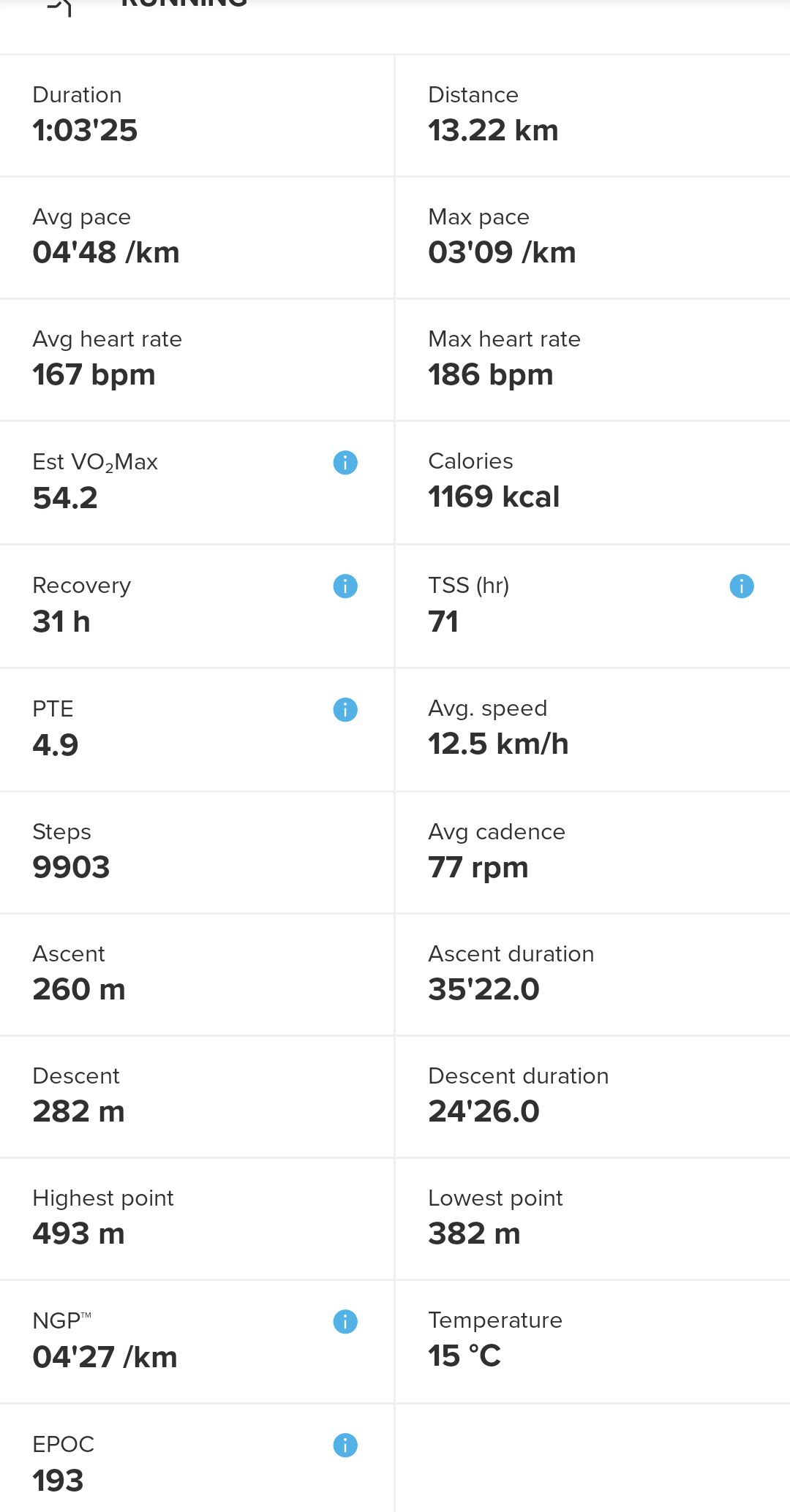
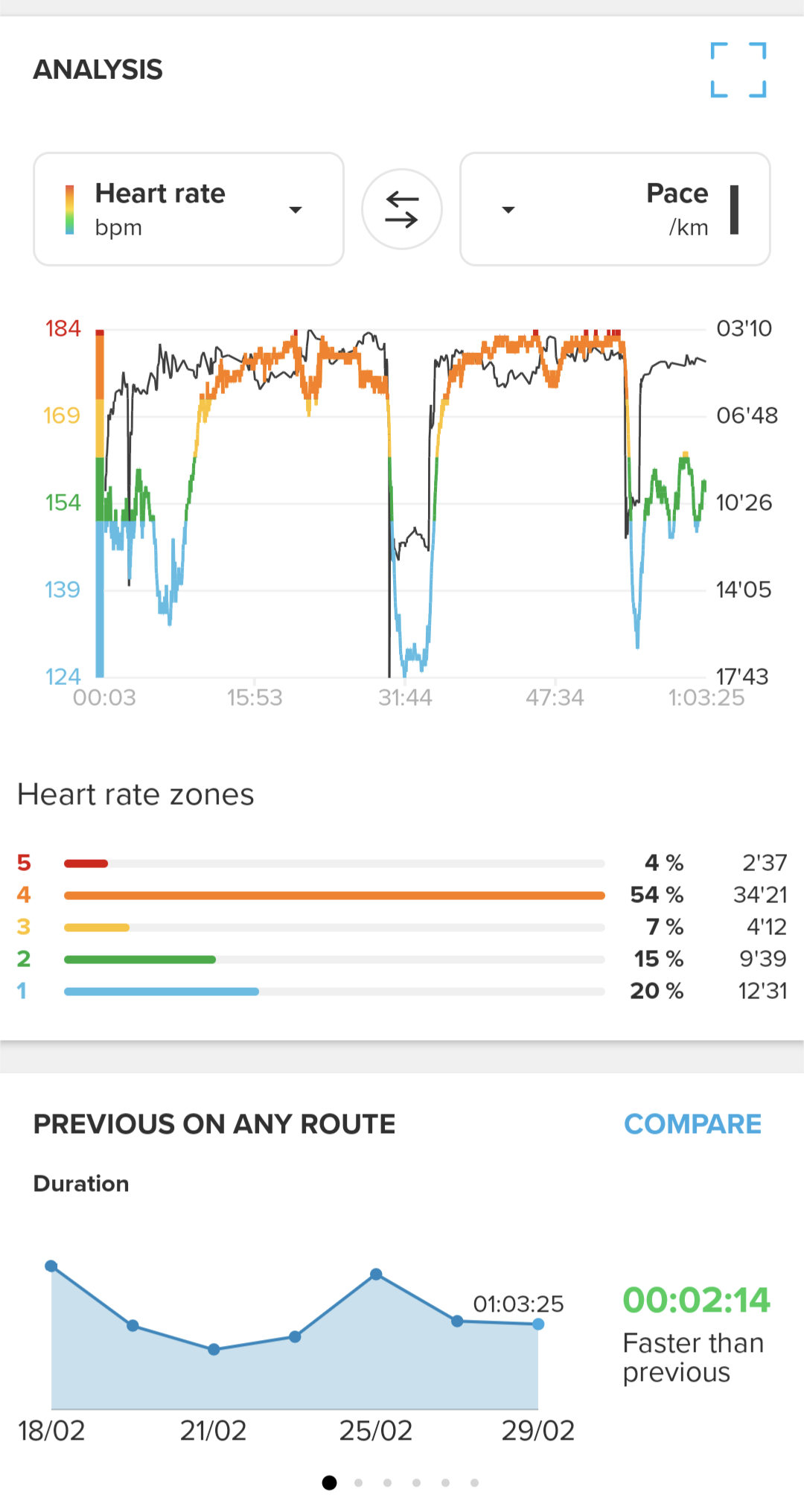
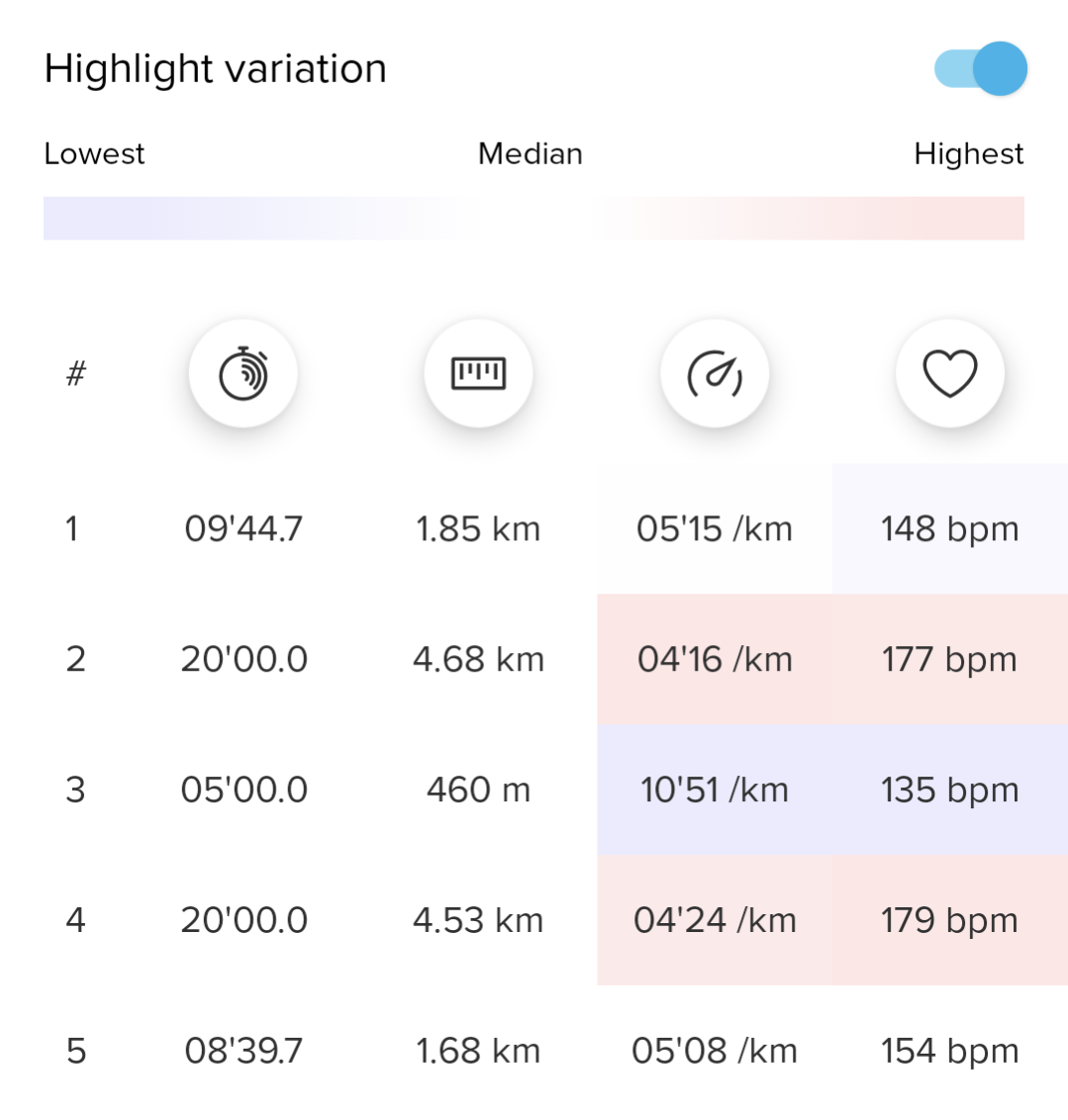
-
@Mazel Looks good did you change the Heart Rate values like i wrote? Looks good one the first look

-
after todays run, i am not sure if only heart rate counts. the following activity is tagged as aerob/anaerob
hr is only zone 1 & 2
tempo zone 1,2,3 (i think are not so accurate, have to find a way to get accurate numbers) and power all zones (i have to make some critical power test runs, or other runs to get accurate power values. will use some steve palladino calculator https://superpowercalculator.com/calculators/6besides the tempo graph is not accurate regarding colors.
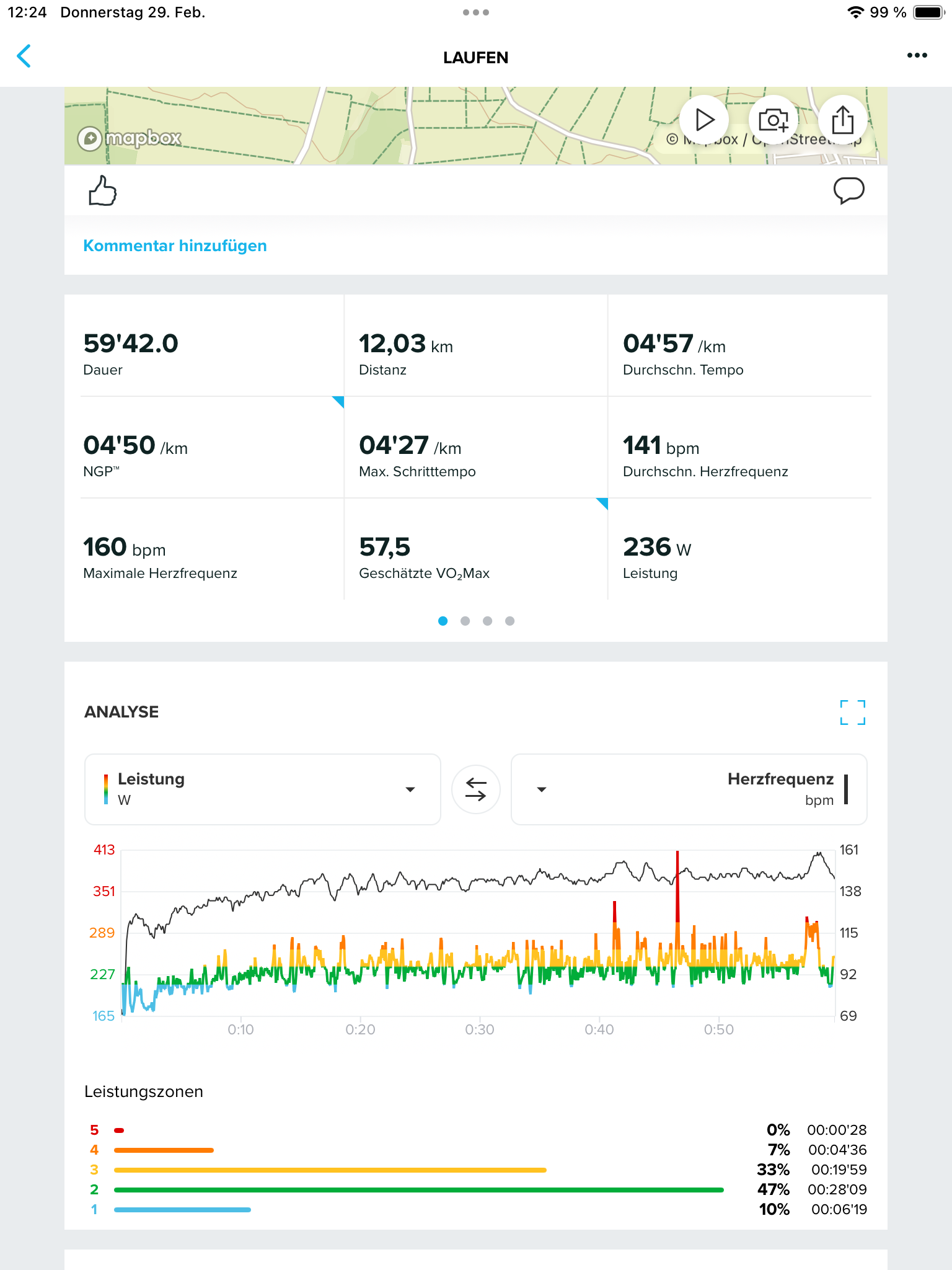
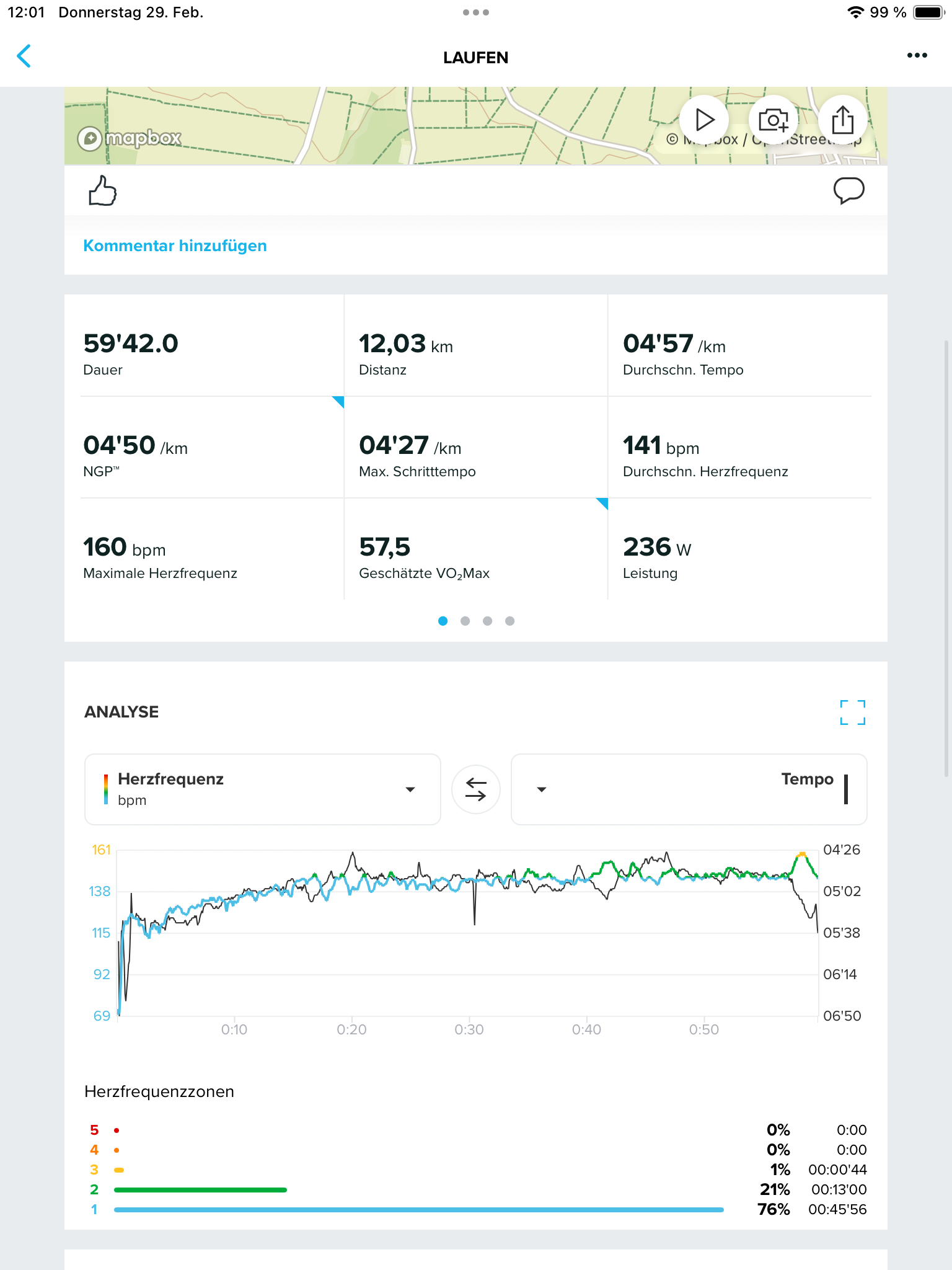

-
@Mazel Zones in the watch are critical. The app will use these and if you set Lactate Threshold too high zone 4/5 then the app won’t record an exercise above that as VO2M. You should set pace and power zones as well.
-
@Mazel Not at all, I kept it at default settings and updated just my HRmax. I remember my max when I was around 20 was 210 during a halfmarathon (with HR belt) and in summer I can hit HR just bellow 200 during shorter runs so I suppose I am still around 200 HRmax. And Suunto gave me the zones based on that. And I think it works, at least now for me. I have already asked lab in our town whether they do lactate threshold tests for runners and not only for cyclists to get an exact value.
@Brad_Olwin Wait a sec, lactate threshold is the edge of zone 4 and zone 5, right? So when I run in zone 4, I should still be under the threshold and therefore not in purely anaerobic zone. Do you have an insight, how is it implemented in the Suunto App? Like “if mean HR is in zone 4 and values are consistent - then it’s VO2max”, “if mean HR is in zone 4 and values are fluctuating - then it’s interval training and it’s anaerobic/aerobic”. This would help me to understand the behaviour. -
@Mazel The zone4/5 number should be your LT, just setting the max is not very accurate. It also helps to set your aerobic threshold at Z 2/3. So yes, if you are in Z4 you are below LT and mostly aerobic but when close to LT may have anaerobic as well. To get VO2M you need to be above LT and I do not know how that is calculated. The app may use pace and power information as well. Those zones should be set and can be inferred from either LT and AT tests or from races you have done.
-
@Brad_Olwin this is exactly what was mentioned in my Intensity Zones post, sorry for the double post.
So to get a good TSS calculation you need to pin the threshold in that Zone 4/5 intersection, so that would be Lactate Threshold, FTP, LT2 or similar. Then to get a good zone representation you anchor the aerobic threshold or LT1 at Zone 2/3.
I have put a quick spreadsheet together using the percentages from @GiPFELKiND post and will test it to see how it goes. Only issue I currently have is trying to do with for the threshold paces
-
@FunkyLarma So VO2max tag is based on the TSS value? I mean the tag, not value.
@Brad_Olwin Thanks for the insight, I will try to get some proper LT value and set up my pace zones as well. We will see whether there would be a difference. -
@Mazel said in How does Suunto App decide, what kind of training (aerobic, anaerobic, etc.) is it?:
@FunkyLarma So VO2max tag is based on the TSS value? I mean the tag, not value.
@Brad_Olwin Thanks for the insight, I will try to get some proper LT value and set up my pace zones as well. We will see whether there would be a difference.I would really hope not, in fact if it is then someone needs a wrist slap.
To be honest I have no idea on the tags assignment, I’m guessing that it is a time and intensity calculation but for it to be right then you need to have accurate zones set in your watch. For example on my first run I did not, and it had me in Zone 5 for 20 minutes; that was tagged as a VO2Max workout. In reality it was an easy run and I was sitting well within an endurance intensity.TSS, or Training Stress Score, is a measure of load and uses a rather complicated calculation to get to a number. Feel three to look it up but the short answer is it uses a known number, be that watts in power, bpm in heart rate or pace in speed as your ‘threshold’ Then it works out how long you spent above and below that threshold to give you how much load you put on your body. Although it is important to remember that not all TSS is created equal. You could do a very long and easy run/ride and get the same TSS score as a much shorter and intense workout. So you kind of use TSS as a guide but then breakdown the time in zones to see which energy systems have been effected by the workout.
So all that said, TSS is separate from intensity zones as a form of measure. However there is no way to set the threshold for TSS directly in the Suuntu platform, but it does occur around the Zone 4 / Zone 5 cross over. If you are only ever using just the Suunto app then set your zones as above and enjoy. If you want to use the Training Peaks metrics then it appears to require a bit more thought, but still enjoy. Always enjoy!
-
If the app shows TSS (.p), does it mean that kind of training is a result of 4/5 threshold power setting?
-
I am also struggling a little bit with this VO2max tag. I did a short cross country skiing race (45min) recently, where my HR was most of the time around my anaerobic threshold. SA tagged this race with VO2MAX, which is correct, in my opinion. If I do VO2MAX intervals in my training (again cross country skiing), SA never tags those trainings with VO2MAX, but instead always aerobic/long aerobic. I think the reason for this is the warmup and cooldown. I always do about 30min warmup, very easy in HR zone 1, with a little bit zone 2 and zone 3. Then the interval part and afterwards 20min to 30min cooldown, again HR zone 1. So I have about 1 hour in zone 1 (+ the rest parts) and this seems to mess up the tagging. I remember on Garmin those workouts have always been identified correctly (aerobic training effect). I guess, If I would just record the interval part, it would be tagged correctly.
On the other hand: If you do a 2h training session and have something like 40min interval on-time, how should SA interpret the training benefit? Are the 1h 20min easy zone 1 more important than the 40min interval on-time? Currently it seems to be the case. Maybe a possibility to edit those tags would be a good idea (including recalculation of all the Suunto Coach stuff).
-
@FunkyLarma That’s what I thought - TSS is like an overall value “how fatiguing the workout was”. Zones determine what energy system of the body is used and what capabilities are hit the most - and therefore gonna probably improve the most. And that brings us back to my first question, that probably noone knows - what conditions need to be me met to get the workout tagged “VO2max”. If it’s “majority of the workout is zone 5”, then it makes sense I don’t have any workout tagged like that, because I get into zone 5 rarely and even when the workout is hard, I spend there ~ 25 % of the time at most.
My former question was probably set too vaguely, I didn’t want to dig into zones and TSS too much. I was just curious, what are the conditions which determine, how is the app tagging the workouts and whether someone have a precise knowledge. Like real numbers, not estimations like “for aerobic, you run on low HR”.
@Maryn IMHO yes - there is the explantion in the app. TSS ( hr ) for heart rate, ( r ) for running pace, etc. Just “open” the workout and you can see icon there.
icon there.
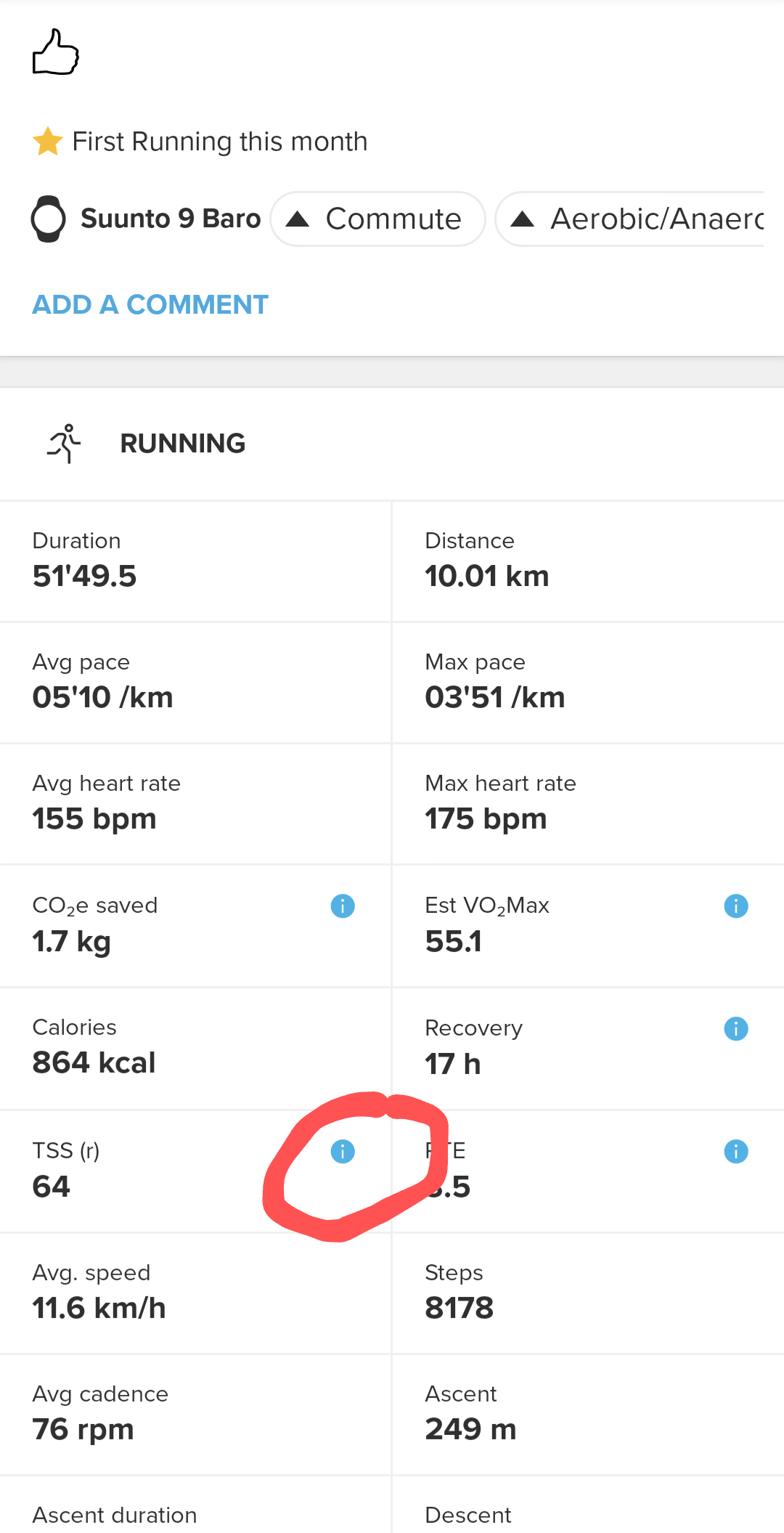
@wmichi are these intervals hard enough? I mean I believe so, but the only thing how SA could say it’s aerobic/long aerobic, is due to really short time in higher zones. I can imagine you go really hard but for short bursts so your HR don’t need to climb so high. Like when you are doing sprints - you’d achieve much higher HR with continuous hard 5 minutes than 60 m dashes with rests between. My last run was pretty easy, but just few of these hills there were enough to rise the HR and SA tagged it aerobic/anaerobic. -
@Mazel yes, as you say the reason they are tagged a certain way is probably down to a complicated algorithm. To be fair other platforms suffer from similar issues and it is very difficult to try and apply a broad brush to all users. I recently carried out a bike workout that contained 1 minute efforts at 110% of threshold. This is something that would hit and target a VO2Max adaptation and another device makers platform informed me I was completely an endurance ride

From your example it would be incredibly difficult to spend long durations in those higher zones, which gets you into the topic of VO2Max training which is always a hotly debated topic with many nuances.@wmichi idea of training the model is a good start but again this would be so dependent on the athlete. Not everyone will hit peak VO2Max at the same outputs or percentages of threshold, You only need to enter into the ‘your ftp is the power you can hold for 1 hour’ debate to see the fun and games.
Personally I would take all of these with a pinch of salt, if not a very large bag full of salt

-
@FunkyLarma I must say, when 1 minute hard efforts are presented as an endurance ride, the algorithm is really… unconvincing
 Yes, I feel the same, it should be taken as an overview. And like I say to my dad, who is using older Garmin watch with wrist HR monitoring - you should not believe exact values (unless you got chest strap in this case) but you can use it to have an overview about the progress. Whether the pace during intervals is going up, HR during easy runs going down, etc. That’s why I take all these calculated values like VO2max with grain of salt, but was curious, how to get VO2max tag.
Yes, I feel the same, it should be taken as an overview. And like I say to my dad, who is using older Garmin watch with wrist HR monitoring - you should not believe exact values (unless you got chest strap in this case) but you can use it to have an overview about the progress. Whether the pace during intervals is going up, HR during easy runs going down, etc. That’s why I take all these calculated values like VO2max with grain of salt, but was curious, how to get VO2max tag.
Btw I was browsing through some workouts of other people in my vicinity and found one man with workout tagget VO2max - and it was like 30 minutes in zone 5. So it seems this tag is really given under the condition of long time in zone 5. -
@Mazel I think it depends on how long you have been in zone 5 in relation to the total duration of the workout. I am pretty sure, that if I was 30min above LT and 1 hour in zone 1/2 during a workout, SA tags this as just aerobic. Yes, the majority of the time this workout was easy, but the benefit of this workout is definitely not low aerobic base training (like it’s tagged). I have had this a lot of times since this feature has been added.
If Suunto Coach is AI driven (I read that a couple of times), then it fails to recognise some sorts of interval trainings correctly. If there’s an ongoing training of this AI, then it should get better eventually. I don’t know, just speculating…
-
@wmichi Yup, I got the same impression. If it’s using machine learning or any type of self-improving algorithm, it should definitely got better learning dataset. I can imagine it’s difficult to distinguish between easy run with some hills which appear like “intervals” but typical interval training is pretty easy to define - speed, HR, time, everything there follows particular trends. It might be interesting to check, whether manual laps help - whether it takes into consideration when you “lap” your warm-up and cool-down and gives it lower weight in the overall classification.
Today was the victorious day! I’ve managed to get “VO2max” tag with the last possible workout structure I haven’t tried before - go almost full out without any intervals, etc. Just run long and hard. So it seems this is the main component. I’ll try shorter distances in the future, but half-marathon in hills did the job. I have checked all my previous workouts since 2020 (2019?) - don’t know when the tags started but it’s my first VO2max workout including all races, etc.
